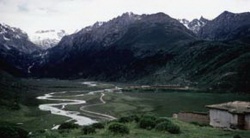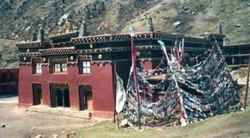The most important and influential institution of the Dzogchen Lineage
Dzogchen Monastery was founded during the seventeenth century in Derge, Kham, Eastern Tibet, and has been the home of many great masters, such as the Dzogchen Patrul Rinpoche. The institution of Dzogchen has kept alive the unbroken lineage of Padmasambhava for centuries through intensive instruction in study and meditation practice.
After its founding in 1685, Dzogchen grew from a small monastery into a major institution within the Nyingma tradition, one of the six major seats of the Nyingma lineage. Soon after its founding, Dzogchen became involved in continuing and preserving the Buddhist teachings in Tibet. For example, in the early eighteenth century, the monastery encouraged the King of Derge to establish a treasury and printing press for the preservation of the Tibetan Buddhist teachings. Many sadhana practices and instruction in rituals were established. A retreat center was established, providing numerous retreatants the opportunity to accomplish meditative and liturgical activities.
Dzogchen quickly became involved in the establishment of an educational and religious infrastructure in the region. Centers were established for the study of sutra and tantra and the Kama tradition. Many texts of the New and Old translation schools of tantras were printed, which were used both in Dzogchen and in other lineages of dharma. In the first part of the nineteenth century, the Shri Singha monastic college was founded, which was to become perhaps the most influential academy in the Nyingma lineage. The practice of Bumdrup Chenmo (widely known as the Konchok Chidu Practice of Peaceful and Wrathful Guru Rinpoche, including the Lion-Face Dakini) and the Tsechu tantric dances of Lama Sangwa Düpa were instituted as annual events.
Dzogchen Patrul Rinpoche (1808-1887), was among the greatest Nyingma masters of the nineteenth century. While in residence in caves near Dzogchen Monastery, he composed The Words of My Perfect Teacher, perhaps the most famous of the "written instructions" (Tib. khrid yig).
During the late nineteenth and early twentieth centuries, Khenpo Shenga Rinpoche (1871-1927), the renowned scholar and adept, composed the word commentaries to the Thirteen Great Treatises. These essential texts, now used by virtually all Nyingma academic institutions as well as some Sakya and Kagyu shedras, were widely published using wood block printing technology. At Dzogchen Monastery and Shri Singha, tens of thousands of pages of wood-blocks of texts from both the Old and New Translation Schools were also published at the end of the century.
More than a single monastery, Dzogchen became a regional center for religious and philosophical education and instruction. By the beginning of the twentieth century, during its height the institution of Dzogchen Monastery encompassed over two hundred branch monasteries with thousands of monks under the auspices of Dzogchen Monastery.
In the first half of the century, construction was extensive, and included the building of many new shrines and temples, including a protectors' shrineroom named Gönkhang Wangdrak Rolpa, a great new five-storied temple commemorating Khenpo Shantirakshita, Lopon Padmakara, and Chögyal Trisong Deutsen, a three-storied Buddha statue (gold-plated on copper), statues of the Three Roots, a three dimensional mandala of the famous "copper-colored mountain," large stupas made of silver and gold, and new Shitro (100 Deities) and Gesar temples. In addition, the shedra and retreat facilities were continuously expanded to accept additional students and retreatants. The annual drupchen practices—seven days of uninterrupted sadhana practice—were initiated. The Monastery engaged in annual offerings of the ever-burning butter lamps and more than 100,000 butter lamp offerings, and other offerings.
Dzogchen Monastery is one of the Six Great Seats of the Nyingma school, the Old Translation school, of Tibetan Buddhism. It is the most important and influential institution of the Dzogchen lineage. His Eminence the 7th Dzogchen Rinpoche, Jigme Losel Wangpo, has re-established Dzogchen Monastery in south India, to preserve the unbroken lineage of Padmasambhava and the Dzogchen Khandro Nyingthig. Dzogchen Monastery, south India is the current seat of the Dzogchen Rinpoches and a flourishing centre of dharma and charitable activity.
The original Dzogchen Monastery in Tibet was established in 1684, by Pema Rigdzin, the 1st Dzogchen Rinpoche. Dzogchen Monastery was renowned for its college, the Shri Singha Shedra, named after the Dzogchen master Shri Singha, who sat down on a rock in the Rudam Valley of Tibet and left a miraculous imprint. In the 19th century, on that very spot, Gyalse Shenpen Thaye, a celebrated scholar and disciple of the 4th Dzogchen Rinpoche, Migyur Namkhe Dorje, built the Shri Singha Shedra. The 4th Dzogchen Rinpoche was the master of Patrul Rinpoche, Ju Mipham and many other great masters.
Dzogchen Monastery was equally renowned for its retreat centres and ritual traditions, in particular the sacred art of lama dancing. During the time of the 5th Dzogchen Rinpoche Thupten Chokyi Dorje, (1872-1935), up to one thousand monks attended Dzogchen Monastery; there were 13 retreat centres and an estimated 280 branches housing tens of thousands of lamas, tulkus, khenpos and monastic sangha.
Reconstruction of Dzogchen Monastery
Dzogchen Monastery in Tibet was destroyed by fire in 1950 during the Cultural Revolution. In the late 1980’s, at the request of H.H. the 14th Dalai Lama, Tenzin Gyatso, His Eminence’ late father, Tsewang Paljor, a great practitioner and expert in Tibetan architecture, began construction of Dzogchen Monastery in the Dhondenling settlement, south India. The rebuilding of the Shri Singha Shedra, the most influential centre of learning in the Nyingma school of Tibetan Buddhism, was completed in December 1991.
In the 1980’s, following the request of His Eminence Dzogchen Rinpoche, Tulku Pegyal, a highly respected Dzogchen lama, came to Dzogchen Monastery from Tibet. Tulku Pegyal held great knowledge of the ritual Dzogchen practices and lead the Drupde, the monastery’s retreat centre and the Dratsung, the ritual department. His Eminence then requested Tulku Pegyal to travel to Nepal to establish Dzogchen Gön Thubten Do Ngag Shedrub Dargye Ling, a branch of Dzogchen Monastery and the two monasteries remain closely connected.
In 1992, H.H. the 14th the Dalai Lama formally inaugurated Dzogchen Monastery and returned in 2000 bestowing teachings from Longchenpa's Samten Ngalso and Semnyi Ngalso and a long life empowerment and blessing of Drupchen Thangtong Gyalpo to the monastic and lay community. H.H. Penor Rinpoche, H.H. Sakya Trinzin, H.H. the 17th Karmapa and many other great masters, from all Tibetan Buddhist schools, have visited.
Home to both the Dzogchen Shri Senha Charitable Society (DSSCS) and the Vidradharya Healing Clinic, Dzogchen Monastery has become a much needed focal point and support centre for the Dhondenling settlement. It is both a centre of excellence for Dzogchen scholarship and ritual and a source of charitable activity that benefits all sentient beings.
After growing into one of the greatest monastic centers in Tibet, the institution known as Dzogchen Monastery continued to expand and develop through the first half of the twentieth century, until the disturbances which occurred throughout Tibet and China beginning in the late 1950s. During the next few decades, the buildings and other sacred objects of Dzogchen Monastery, including the library, were completely destroyed. In the early 1980s, a long process of rebuilding the Dzogchen Monastery started, and is still continuing.
At present, the smaller temple called Lhasar has been rebuilt and there are about 300 monks who are receiving training in tantric ritual arts, studies and practices of the Dzogchen lineage. The main temple and shrine has not yet been restored. Currently there are about five older Rinpoches who are leading the monastery and training the younger generation of teachers and disciples. Among them Tulku Kasang has, with extraordinary dedication, taken overall responsibility for rebuilding and guiding the Shri Singha shedra. Tulku Drukpa Kuchung and the late Kunsang Tulku have taken responsibility for rebuilding and guiding the main monastery, and completely dedicated themselves to its well-being.
Tulku Kalsang, an exceptionally learned and skilled master, Tulku Drukpa Kuchung, the oldest and most knowledgeable tulku in the Vajrayana lineage and the ritual arts of the Dzogchen tradition, and Kunzang Tulku, an individual of incomparable compassionate heart and great accomplishment in meditation practice, have together worked as an exceptional team in rebuilding the Dzogchen monastic institution in the Twentieth Century. Throughout the rebuilding of Dzogchen Monastery they have continuously consulted with the reincarnations of the Abbots who now live in India.
Tokden Tulku, Chokley Tulku, Tulku Tenphel, Tulku Pegyal and other teachers have given irreplacable support to Dzogchen, and untiringly contributed their efforts in rebuilding this great institution.





